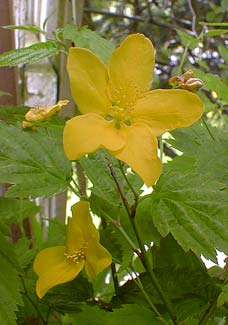
The Kerria Rose
or, Yamabuki
Frogs sing
As we pluck the yamabuki blossoms
To float the petals in our sake cups.
So pleasing our spring outing!
-Ryokan
(1758-1831)
(1758-1831)
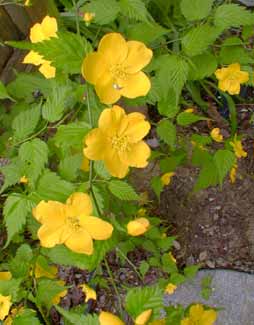 Quite some while ago I decided I wanted a Kerria, which is a deciduous shrub that blooms superbly in a shady spot, & which has gorgeous bright green stems to put on their own show in leafless winter.
Quite some while ago I decided I wanted a Kerria, which is a deciduous shrub that blooms superbly in a shady spot, & which has gorgeous bright green stems to put on their own show in leafless winter.The only variety of Kerria offered locally was the "double" which has pompom flowers nearly identical to those of Lady Banks' Yellow Rose. Now that's a gorgeous bloom, but it wasn't what I wanted. I wanted an ordinary, single yellow kerria which I personally regard as having a level of beauty exceeding the fancier & more popular double.
It took so long to find this specimen that there were times I almost gave up & settled for the double. But this can become an enormous shrub after a few years, so I held off patiently for the one I most wanted.
When I finally spotted one specimen of the single amidst about fifteen three-gallon-sized doubles, I grabbed it immediately. This was at Bainbridge Gardens, & when I mentioned to Junkoh I'd been looking for the natural single form for ages, he told me it had taken him three years to find any, & as soon as they came in, they began to sell much more rapidly than the doubles, & at that moment I was buying the last one. "Rumor" had gotten out that he had them, & one customer drove all the way around Puget Sound to get one.
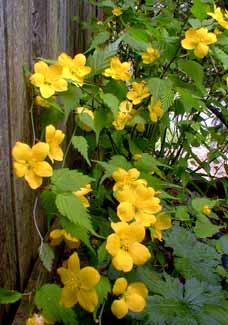 And here I had always thought I was in the minority regarding the normal single as more wonderful than the fancy double! If I'd visited the nursery a day later I probably would not have known they'd been offered at all.
And here I had always thought I was in the minority regarding the normal single as more wonderful than the fancy double! If I'd visited the nursery a day later I probably would not have known they'd been offered at all.If there is any sense to the general preference for the double-kerria, it is the fact that it does bloom longer. Like many doubles in the flower kingdom, it is the flower's sexual parts that are lacking, forming more flower petals instead of stamins & pistils.
Thus the double waits & waits to be pollinated, but never can be. The single-kerria's blooms individually fall to pieces after a couple of days, & there are allusions in classic poetry to these petals having fallen from shrubs along riverbanks, drifting away in the current, symbolic of the brevity & vagaries of even human lives.
Hardy zones 4 through 9, this native of Japan & China requires part shade or bright shade & evenly moist well-drained soil. Once established, it can become realtively drought-hardy, but to bloom at its best should not experience drought.
Though it can tolerate more sun, the blossoms will bleech out quickly without some shade. It will thrive in the deepest shade but not bloom much, as it prefers dappled sunlight to bloom at its mightiest.
In our garden it blooms most dramatically mid-March until the end of May, with occasional flowers recurring in summer & early autumn. The first photo above is from May of its first year (2003) & the second photo from March of its second year in our garden (2004).
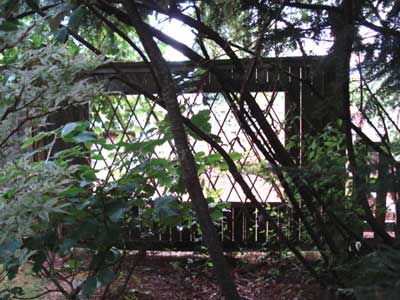 Surrounding shrubs outgrew it until by about 2007 it was in more shade than was optimal. So in 2009 Granny Artemis & I cut the entire center out of a six-foot-tall fence & attached a bamboo trellis to the window, restoring a proper dose of light to that shade garden. So that grey fence so clear in the third photo above is now mostly a bamboo-crisscrossed opening.
Surrounding shrubs outgrew it until by about 2007 it was in more shade than was optimal. So in 2009 Granny Artemis & I cut the entire center out of a six-foot-tall fence & attached a bamboo trellis to the window, restoring a proper dose of light to that shade garden. So that grey fence so clear in the third photo above is now mostly a bamboo-crisscrossed opening.Our specimen was obtained as a youngster in a three-gallon pot but it grew rapidly & was already very impressively bushy by its second spring. It eventually grew to six feet of height. It has an almost limitless spread by suckering, & popped up on its own on the sunny side of the fence.
It would be a low-maintence shrub if not for needing to stay on top of its suckers to limit it to the size wanted. The suckering youngsters are easily sliced with shovel from the parent & transferred to pots. It's a choice whether to cut suckers flush to the ground, or dig some of them out with a little bit of root to pot up for friends.
It blooms on year-old stems, so any pruning one wishes to do should be immediately after its primary bloom; if pruned too early you'll be removing that year's buds, & if pruned too late you'll be cutting off branches that have already expended energy setting buds for the year after that.
It is exceedingly pleasant with its serrated bright green leaves, yellow flowers, & its unique intensely yellow-green limbs that retain their color year-round & make the Kerria Rose such an excellent choice for the winter garden. The autumn colors vary & not guaranteed to be bright, but ours has very fine yellows for autumn (see the Kerria Page of the Autumn Leaves Gallery).
Though called Kerria Rose or Japanese Rose, most people wouldn't recognize it as of the rose family, as it has no thorns. It is the only species in its genus, with three varieties, the natural yellow, the double yellow, & a white single. The double-form, K. japonica pleniflora, was the first variety to reach western gardens, specimens arriving in England in 1805.
It is named for the late Victorian English botanist Robert Kerr who first described it to the west. In Japan it is called Yamabuki, "The Mountain Flower," because it grows wild along mountain streams & rivers.
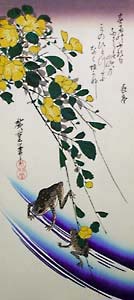 It is frequently alluded to in The Tale of Genji by Princess Murasaki Shikibu. As a mountain dweller the Kerria Rose would naturally be assumed to bear many of the traits of monastic seclusion & Buddhist kindness, as well as of innocence & youth.
It is frequently alluded to in The Tale of Genji by Princess Murasaki Shikibu. As a mountain dweller the Kerria Rose would naturally be assumed to bear many of the traits of monastic seclusion & Buddhist kindness, as well as of innocence & youth.The shrub is especially associated with the Ide Tamagawa, a river near Kyoto, which was well-famed for Yamabuki that flourish along its banks. Flower-viewing excursions were arranged among courtiers & courtesans specifically to observe Yamabuki in spring along the Ide Tamagawa. These excursions could be very expensive, & men who idled away their time in pleasure district activities were said to be "scattering gold coins as the Yamabuki scatters golden petals."
Hiroshige in 1830 illustrated the Kerria Rose overshadowing two frogs, in one of a famous series of plant portraits accompanied by the opening lines of poems. The jist of the poem that accompanies the famous picture can be paraphrased: "Frogs are calling in the spring rain, when the Yamabuki fails to shelter them."
Why does the Kerria fail as a rain-shelter for frogs? Perhaps literally because the frogs are active so early in the spring that the Kerria hasn't yet regained all of its sheltering leaves. But the poem alludes to a mino which is a raincoat made of grass, punning this with the same word that means "seed" or "fruit." The Yamabuki is proverbially believed to be sterile, thus cannot provide the frog with a raincoat (mino) because it has no fruits (mino).
The pun is no mere jest, however, for it embodies a Buddhist sense of mono-no-aware, the sadness of things. So the poem's sentment could be rephrased: "The Yamabuki has flowers like the brocade robes of the wealthy, yet it is so poor it cannot afford even a grass raincoat."
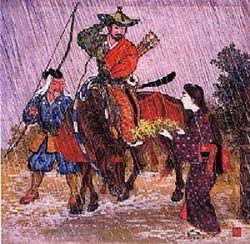 Relating to this is a tale well worth retelling, regarding the Kerria Rose & the 15th Century samurai, Ota Dokan, who served the Hojo Clan.
Relating to this is a tale well worth retelling, regarding the Kerria Rose & the 15th Century samurai, Ota Dokan, who served the Hojo Clan.General Dokan had ridden from Chiyoda (Edo) Castle to go hawking. He had gotten as far as Ogose village in Saitama when an unexpected storm broke forth.
He reigned aside his horse at the doorway of a roadside inn, which was so run-down it looked like a haunted ruin. A serving maid came to the door. General Dokan called to her, requesting the loan of a grass raincoat.
She hurried away & returned to him with an open fan, upon which lay a Yamabuki flower, presenting this with extravagant courteousness.
Dokan expressed himself angrily at the nonsensicality of her actions. He returned to Chiyoda Castle soaking wet, & in a bad mood.
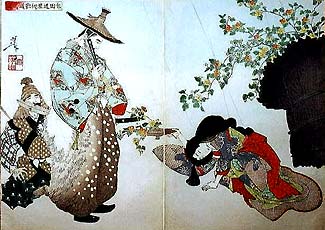 Later his old retainer explained to Dokan, "That maiden intended to remind you of the poem 'Yamabuki-no-Mino,' for the word mino (grass raincoat) also means 'seed.'" Then the old retainer sang, "The Yamabuki enriches our house with flowers, yet there is sadness here, for these riches are an illusion, & our flower has no mino."
Later his old retainer explained to Dokan, "That maiden intended to remind you of the poem 'Yamabuki-no-Mino,' for the word mino (grass raincoat) also means 'seed.'" Then the old retainer sang, "The Yamabuki enriches our house with flowers, yet there is sadness here, for these riches are an illusion, & our flower has no mino."Dokan belatedly realized the maiden had no raincoat, the inn being so impoverished it could not afford even a thing so humble as the woven grass from which raincoats were made. He was regretful that he had become angry due only to his lack of knowledge. From that moment on, he was devoted to poetic studies, so that thanks to a poor innkeeper's daughter, he was in time himself a great poet.
The roadside encounter is commemorated in an old painting reproduced above. It was further depicted by woodblock designer Yoshitoshi, in the diptych shown here, though in this version the maiden offers Dokan a Kerria sprig on a tray rather than a blossom on a fan.
So well known is this tale throughout Japan, to this day many people believe all Kerria roses have no seeds, but of course it is only the double-form that has extra petals instead of stamins thus is sterile; the single Kerria seeds fine.